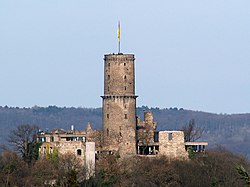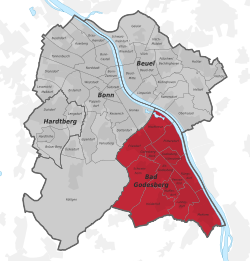Bad Godesberg(Kölsch:Bad Jodesbersch) is a borough (Stadtbezirk) ofBonn,southernNorth Rhine-Westphalia,Germany. From 1949 to 1999, while Bonn was the capital of theFederal Republic of Germany,most foreignembassieswere in Bad Godesberg. Some buildings are still used as branch offices orconsulates.
Bad Godesberg | |
|---|---|
 Godesburgruins | |
| Coordinates:50°41′N07°9′E/ 50.683°N 7.150°E | |
| Country | Germany |
| State | North Rhine-Westphalia |
| Admin. region | Cologne |
| District | Bonn urban district |
| Town | Bonn |
| Government | |
| • Borough mayor | Christoph Jansen (CDU) |
| Area | |
• Total | 31.97 km2(12.34 sq mi) |
| Elevation | 46 m (151 ft) |
| Population (2020-12-31)[1] | |
• Total | 76,156 |
| • Density | 2,400/km2(6,200/sq mi) |
| Time zone | UTC+01:00(CET) |
| • Summer (DST) | UTC+02:00(CEST) |
| Postal codes | 53173-53179 |
| Dialling codes | 0228 |
| Vehicle registration | BN |
| Website | Website |
Geography
editBad Godesberg is located along the hills and cliffs of the west bank of theRhineriver, in west central Germany. Godesberg is also the name of the steep hill, of volcanic origin, on the top of which are the ruins of theGodesburg,a castledestroyed in 1583during theCologne War.
History
editThe following events occurred, per year:
- 722 - First official record of the town, which was named after a nearby mountain, the Woudenesberg (later Godesberg), abasaltcone where theUbii,aGermanic tribe,worshipped the godWotan.[2]
- 1210 - On 15 October,Archbishop of CologneDietrich Ilays the foundation stone of theGodesburgfortress on the Godesberg mountain.
- 1583 - On 17 December, theGodesburg was destroyedbyBavariantroops after ArchbishopGebhard Truchsess von Waldburgconverted toProtestantism(seeCologne War).
- 1792 - Godesberg becomes a spa resort, with the opening of theRedoute,which later saw receptions of thePresident of Germany.
- 1925 - Godesberg is allowed to call itself "Bad" Godesberg, identifying it as aspa.
- 1935 - Bad Godesberg attains the status of a town.
- 1938 -Neville Chamberlainmeets withHitlerover theSudetenlandcrisis at the Rheinhotel Dreesen in Bad Godesberg. Hitler's demands concerningCzechoslovakiaexpressed inGodesberg Memorandum.
- 1944–1945 - Bad Godesberg was the location of a Nazi-operatedforced labourcamp.[3]
- 1945 - On March 8, Bad Godesberg was the first major German urban district to be transferred toAlliedforces control without a battle.
- 1959 - TheSocial Democratic Party of Germany(SPD) decided on a new party program, theGodesberg Program.
- 1969 - Godesberg was incorporated into the city of Bonn. Since that time, it has been referred to as the "posh part of Bonn".
Infrastructure
editBonn-Bad Godesberg stationis on theLeft Rhine lineand the line 16 and 63 of theBonn Stadtbahn.
Circa 2018 a new police station was being built on formerHariboproperty.[4]
Politics
editList of twin cities/sister cities
editBad Godesberg istwinnedwith:[5]
- Saint-Cloud,France (1957)
- Frascati,Italy (1960)
- Windsor and Maidenhead,England, United Kingdom (1960)
- Kortrijk,Belgium (1964)
Friendly cities
editBad Godesberg has friendly relations with:[5]
- Steglitz-Zehlendorf (Berlin),Germany (1962)
- Yalova,Turkey (1969)
Culture and attractions
editPublic facilities
edit- Schauspielhaus Bad Godesberg(Theater Bad Godesberg), the biggest theater of Bonn’s city stages
- Kleines Theater im Park (Small Park Theater), venue for theater,boulevard theater,andmusicalswith few actors
- Haus an der Redoute (House at the Redoute), previously an electoral theater, is nowadays a facility for changing/rotating art galleries
- Piccolo Puppenspiele (Piccolo’s Puppet Show), puppet theater that also travels
- SmallBeethovenhall as the headquarters of the Heimatbühne Muffendorf (Home stage of Muffendorf)
Bad Godesberg in literature
editA whole series of literary works take place in Bad Godesberg. The protagonist ofJuli Zeh’s novel "Spieltrieb"(Gaming instinct) are students at the school Päda. Occurring locations in the novel are the school and the villa district. Heinrich Böll’s novel "Frauen vor Flußlandschaft" is set in the villa district between Bonn and Bad Godesberg. On October 30 the documentary piece "Zwei Welten"(" Two worlds ") byIngrid Müller-Münchhad its premiere as a chamber play. The author explains that it shows Bad Godesberg in the change of time. It is a city where the worlds of "rich German people" and migrants collide. Nine actors perform excerpts from a protocol of mostly young inhabitants of Bad Godesberg, that Müller Münch took record of. In the pre-report of the piece, theFrankfurter Rundschaucalled it a "Bad-Godesberg-Phänomen" (Bad Godesberg phenomenon). According to Müller-Münch, these two worlds were closer in Bad Godesberg than they were anywhere else.
Recurring events
edit- Rhein in Flammenon the first Saturday of May: Large Firewokrs and a Ship tour from theLinz am RheinalongErpel,Unkel,Remagen,Rheinbreitbach,Rhine islandNonnenwerthat Rolandswerth/Bad Honnef,Bad Godesberg,Königswinterto the Rheinaue inBonn
- FeenCon
Over the course of each year, there are always many diverse events and festivals that are being organized by the Stadtmarketing Bad Godesberg e.V. (city marketing department of Bad Godesberg). Some of which are flea and antique markets, a French market, a kids’ rally ( "Tag der Kleinen Bad Godesberger" / "Day of the small Bad Godesbergers" ), a city party, a Christmas Market, and a street food festival. The 23rd German Fire department day took place in Bad Godesberg from June 21 until June 25, 1961. The first CTIF Games took place in Bad Godesberg, since then the International Association of Fire and Rescue Services CTIF organizes the event every four years in different cities.
Rhenish traditions
editSeveralCarnivalclubs have devoted themselves to the upkeep of Rhenish traditions, especially the Godesberger Stadtsoldatenkorps (city soldier corps), the Fidelen Burggrafen (merry burgraves) and the AKP (Allgemeine Karnevals Gesellschaft, General Carnival Society). The Coordination Committee of each Carnival Association is the FAGK (Festausschuss Godesberger Karneval, Festival Committee of Godesberger Carnival). In the carnival season, the clubs also organize a variety of meetings, and on the carnival Sunday a lavish parade. All clubs engage inyouth work.
Education
editSecondary schools
edit- Nicolaus-Cusanus-Gymnasium(NCG)
- Aloisiuskolleg(AKO), partnerschool of the CFG
- Amos-Comenius-Gymnasium Bonn(AMOS/ACG) (DE)
- Clara-Fey-Gymnasium(CFG), partnerschool of the AKO
- Konrad-Adenauer-Gymnasium(KAG) (DE)
- Pädagogium Godesberg - Otto-Kühne-Schule(PÄDA)
International schools
edit- Bonn International School(BIS)
- Independent Bonn International School(IBIS)
- King Fahd Academy(closed)[6]
Notable residents
edit- Paul Kemp(1896–1953), stage and film actor
- Klaus Barbie(1913–1991), SS and Gestapo functionary during WW II, war criminal known as "the butcher of Lyon".
- Michaela Endler(born 1945), former cross-country skier
- Harald Weinberg(born 1957), politician (The Linke)
- Johannes B. Kerner(born 1964), television host and journalist.
Trivia
edit- John le Carré's novelThe Little Drummer Girlbegins with the bombing of the house of theIsraelilabourattachéin Bad Godesberg.
References
edit- ^"Bevölkerung in der Bundesstadt Bonn Stichtag 31.12.2020"(PDF).Bundesstadt Bonn Statistikstelle.Retrieved28 September2021.
- ^Stiehl, Eckart (1997).Die Stadt Bonn und ihr Umland: ein geographischer Exkursionsführer.Ferd. Dümmlers Verlag.ISBN978-3-427-71661-7.
- ^"Arbeitserziehungslager Bonn-Bad Godesberg".Bundesarchiv.de(in German).Retrieved21 August2022.
- ^"Haribo is leaving Kessenich – almost".General-Anzeiger.2018-05-15.Retrieved2024-03-28.
- ^ab"Städtepartnerschaften. Städtefreundschaften".bonn.de(in German). Bonn.Retrieved2021-02-10.
- ^"Authorities To Close Muslim School in Bonn."Deutsche Welle.11 November 2003. Retrieved on 24 July 2016.
External links
edit- Official website(in German)
- Bad Godesberg section of Bonn city website(in English)




